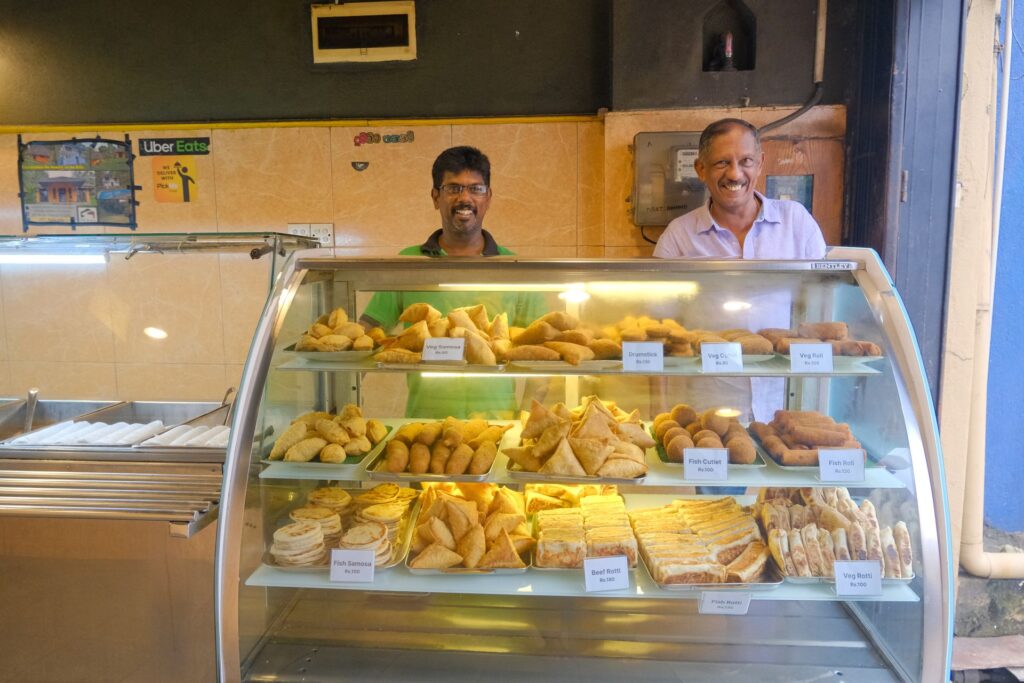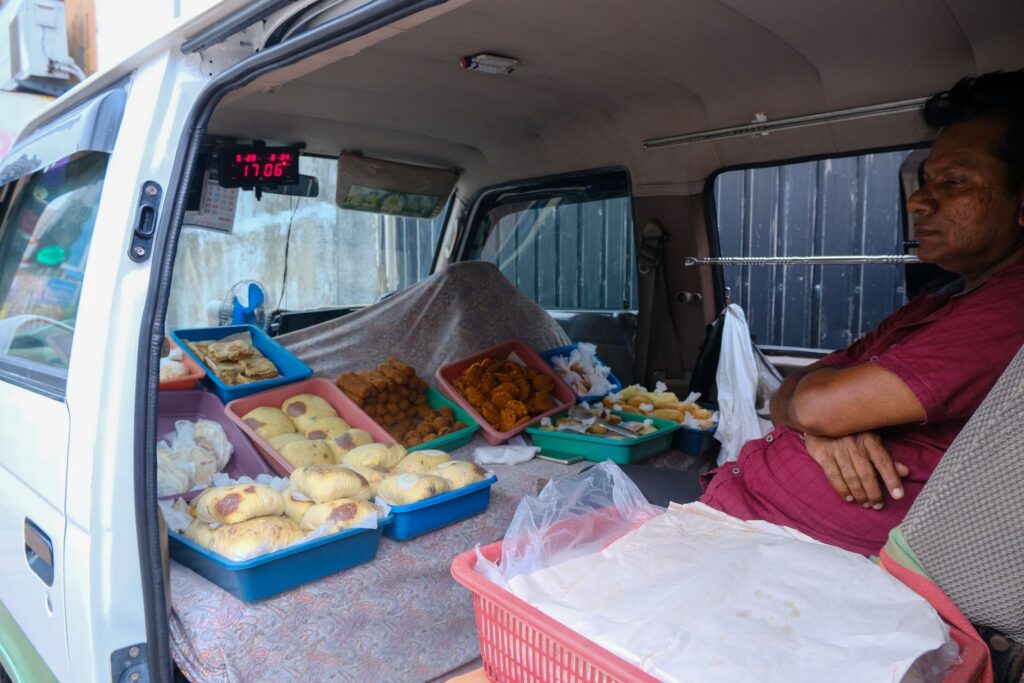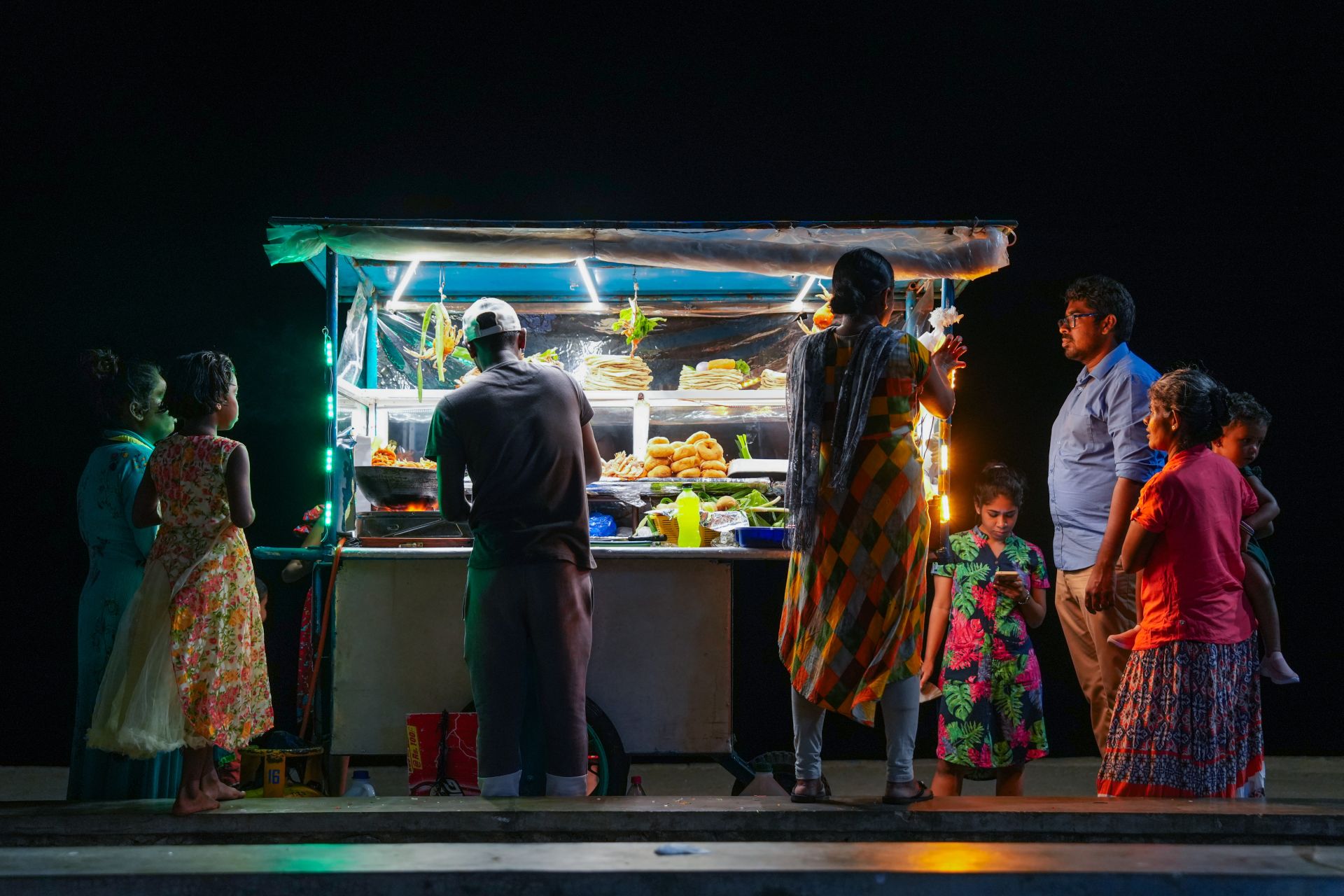For nearly 34 years, as the clock struck 5 in the late afternoon, Nalin Dayasagara would open his takeout food joint in the W.A. Silva Mawatha neighborhood of Colombo, one of the many multicultural neighborhoods in the Sri Lankan capital. As the sun would dip below the horizon, the 64-year-old’s small business, Sagara Foods, would swarm with hungry passersby. Some of them would be there to pick up dinner, but most of them would come for what are known in Sri Lanka as short eats.
It is nearly impossible to define short eats. But simply put, short eats are snacks, a quick hunger fix, but they can be had at all times and for all meals. Any time anyone wants to snack — and even if they don’t want to — no one says no to short eats when offered. You’d find them being served on beach sides and busy roads, at birthday parties, corporate events, high teas and many other types of gatherings in the country.
Short eats bind communities together all across Sri Lanka. They are a source of joy and sustenance, and also hold stories of the nation’s centuries-long history. They are a mishmash of diverse culinary traditions left by several colonizers and settlers, including the Indian, Dutch, British and Portuguese, among others, and have emerged as a symbol of the Sri Lankan identity, both in the diaspora and at home. Since the 2022 economic crisis, which reduced people’s purchasing power, Sri Lankans have increasingly turned to short eats for a quick meal fix.
At Sagara Foods, short eats are neatly stacked on small trays, displayed in a glass cabinet with brightly laminated price tags. They include different kinds of rolls, patties, cutlets, pies, “vadai” (deep-fried lentil fritters) and charred fish roti (flatbread) loaded with a turmeric-hued curried mix of vegetables, spices and canned tuna. But rolls are the most popular, said Dayasagara. They are thin pancakes stuffed with chicken and vegetables, breaded and fried in hot oil. While some short eats are spicy, others like “kimbula banis” — which translates to crocodile bun because it’s vaguely shaped like the reptile — are sprinkled with sugar.

When I was around 7, my mother, who like many people call them “shorties,” would take me to town some weekends to a famous bakery where the waiter would bring a plate full of short eats: buns, rolls, cutlets, pies and samosas. But soon I figured out my regular order: a chicken-stuffed floss bun, a breaded and deep-fried cutlet, and a glass of sugary milk coffee. At school, I would skip math class for “maalu paan” (spicy, fish-stuffed baked buns) breaks with friends. In Colombo, when I juggled university with two jobs, I would turn to short eats for sustenance, because that made sense for a struggling 20-something with little money and time: cheap, filling and quick to eat.
As one traces its history, short eats tie in different historical strands and culinary influences in Sri Lanka.
“You really can’t pinpoint it,” said Ranji Thangiah, a London-based food photographer, recipe developer and food blogger of Sri Lankan heritage. “But they reflect many influences of colonization, immigration, trade and war, all of which have left their mark on short eats.”
For instance, patties — deep-fried, dainty and flaky crust pastries stuffed with fillings like spicy canned mackerel, potato, vegetable, chicken or beef — could have come from the British and their pastry-covered pies. (The British ruled over the island from 1815 until the country gained independence in 1948.) “Yet, they are remarkably similar to the Portuguese and South American empanadas,” said Thangiah. They are also close relatives to the Malaysian curry puffs — pastry shells stuffed with curried meat or potato. When the Dutch ruled over the island from 1658 until 1796, many Malays arrived in Sri Lanka from the present-day Indonesian archipelago and the Malay Peninsula, remaining on the island as a minority ethnic group.
Similarly, the deep-fried cutlet filled with spiced fish and potato was possibly derived from the Portuguese bolinho, said Thangiah. “You find similar snacks in Brazil [another former Portuguese colony] made with deep-fried salt cod and potato.” Even in Goa, the Indian state on its southwestern coast, where the Portuguese ruled for nearly four centuries, beef cutlets — coated with semolina — are ubiquitous. In Sri Lanka, the Portuguese ruled over the island’s coastal belt for over 150 years beginning in the early 16th century, controlling trade in the region.
Chinese rolls, which are popular in Sri Lanka, might not be found in China, said Thangiah. But one can trace their history to the Chinese settlers who migrated to Sri Lanka from the 17th to the 19th centuries. They are similar to deep-fried Chinese spring rolls, though the Sri Lankans adapted them for their palate by adding breadcrumbs.
Tilak Senaratne, a chef at Green Cabin, one of Colombo’s oldest bakeries, traces the culture of short eats to the English afternoon tea traditions under British rule. In 1884, a group of British planters had established the Ceylon Tea Kiosk at the Colombo Harbour for sampling tea, which later relocated into a building at Colombo Fort and expanded into the Pagoda Tea Rooms. Many people believe that the tea room introduced pastries to Sri Lanka.
After World War I, Mudaliya Thomas Rodrigo, a local entrepreneur, took control of the Pagoda Tea Rooms. Later, his son Cyril Rodrigo took over, and during World War II, he borrowed money and purchased the Green Cabin from a local business owner. His business thrived thanks to both locals and visiting Europeans stationed in Colombo.
From the 1960s to 1980s, “the Green Cabin became a place where people used to hang out,” said Senaratne. “It was everyone’s place to go for their first date or after-salary treats.” This led to the rise of many other local bakeries in the country. By the 1960s, several famous homegrown bakeries sold a range of short eats. Even though the historic Pagoda Tea Rooms shuttered, Green Cabin, with several branches across Colombo, is still run by the original family, now in its fifth generation, and continues to be one of the city’s prominent places for short eats.
In the late 1970s, as Sri Lanka became a market economy and people started migrating from smaller towns and villages to bigger cities, they were on the lookout for cheaper food they could grab and go, short eats became even more ubiquitous. “And so, it became a staple in our diet,” said Senaratne, who enjoyed his first crumbed roll at the school cafeteria in the early 1980s.
Short eats have also evolved over the years across diverse cultures and communities, sometimes melding with local customs and sometimes being reinvented entirely. For instance, the “medhu vadai” or “ulundu wade,” a deep-fried doughnut made of black gram, traversed both southern India and Sri Lanka. In Tamil restaurants, it is often served with coconut chutney, while the Sinhalese, like my family, eat them plain on buses and trains, while at home, they pair it with a cup of sugary black tea.
Nalintha Costa, a resident of the Colombo suburb of Wattala, remembers growing up among his father’s larger Catholic and the ethnic Burgher (descendants of Europeans who intermarried Sinhalese and Tamils) community, snacking on bacon buns. They were mixed with a sweet and spicy “seeni sambol,” a caramelized onion relish.
“Some places would sell shepherd’s pie, but instead of chicken, they put bacon,” he said. “But you wouldn’t easily find these bacon varieties in Colombo.”
Back at Sagara Foods, Dayasagara offered me beef roti, a spicy beef mix encased in a flatbread and warmed in a pan, which he introduced to the menu after noticing throngs of Muslims frequenting his small shop.
“Many Sinhalese people don’t cook or eat beef because beef carries a stigma,” he said. “But I don’t see a problem with beef.” As the cow is considered sacred in Hinduism, many Sri Lankan Hindus avoid the consumption of beef.
Dayasagara is Sinhalese and employs 12 people, all of them Tamil. But being in a largely multicultural neighborhood, everyone across religions, cultures and ethnicities looks for Sagara’s beef roti. “Muslims buy over half of it, and some Hindus would order it with a hushed voice so no one would hear what they say,” Dayasagara said with a smile.
The nearly three-decade-long Sri Lankan civil war between the Sri Lankan army and the Liberation Tigers of Tamil Eelam (LTTE) has also left a mark on short eats, said Thangiah. “This was when a short eat called ‘mithivedi’ — meaning land mine — came into place,” she said. The snack is a flattened, breaded and deep-fried Chinese roll filled with a curried mix of mutton, egg and potato. Its origins are tied to the northern region of the country, a foothold of the LTTE ravaged by the war.
But for those outside Sri Lanka, short eats are an emblem of identity. “Each bite serves up a dose of nostalgia,” said Thangiah, who is now based in Tooting, a south London district home to a large community of the Sri Lankan diaspora. “For me, short eats hold memories of the gatherings my parents would have with relatives and friends arriving to eat, drink, discuss, debate, and attempt to solve Sri Lanka’s problems from our small living room in a suburb of London.”
She fondly recalled her mom’s cutlets, in which she would mix tinned mackerel with potatoes, chili, onions and spices in a large plastic container, then shape them into balls the size of a walnut. She would dip them into beaten eggs and bright orange breadcrumbs before deep-frying them. “We would be treated to a few straight out of the fryer. Too hot to hold, I’d bite through the crisp outer crust into hot spicy fish. It was always sublime,” said Thangiah.
As Thangiah grew up in the U.K., short eats were known only among the Sri Lankan community. After a visit to the Sri Lankan grocery store with her parents, Thangiah would come home with a brown paper bag filled with mutton rolls. “And you would eat them in the comfort of our home,” she said.
But now, with many Sri Lankan restaurants, pop-ups, supper clubs and street food stalls in London, Thangiah said that Sri Lankan food is fast becoming popular. Short eats, she explained, are going mainstream, easy to find on restaurant menus among the starters. They are also increasingly part of some of London’s high tea experiences.
When Thangiah hosts parties, she serves her guests short eats. “For my non-Sri Lankan guests, short eats signify who I am and where I am from,” she said.
When I last visited Sagara Foods in late May, Dayasagara told me that short eats are becoming more popular, perhaps because for many Sri Lankans today they are no longer a choice but a necessity.
As people’s purchasing power depleted after the economic crisis in 2022, more of them began resorting to short eats to feed their hunger. In Galle city, 80 miles south of Colombo — where I now live — small tuk-tuks transform into stationary food carts every evening. A pack of four “maalu paans” sells for 100 rupees, about 33 cents. But they are no longer filled with fish, instead stuffed with a spicy potato filling. Bikes, cars and vans stop along the way, buying them in hundreds. They sell out quickly.

Short eats are also crucial to those who make them. Muthu Robert is the main pastry chef at Sagara Foods. He moved to Colombo from the hilly town of Badulla looking for work almost three decades ago and learned to make cutlets, rolls and patties on the job. Since then, he has been supporting his family back home making short eats. “I visit them during the New Year,” he said.
When Robert began work, Sagara Foods was a tiny hole in the wall with a tin roof. From the outside, this takeaway joint with a bright neon green menu still looks tiny. But the kitchen has expanded since then. His mother ran a grocery here before Dayasagara began the food business.
Today, one of Dayasagara’s two sons lives in Melbourne, Australia. The other son, who was present during my visit to Sagara Foods, works for a company in Colombo. Dayasagara hopes that one of them will someday take over the business.
“Everything’s there now because of Sagara,” he said, looking at his son. His son smiles, almost dutifully. He doesn’t say no.
During my many conversations, both within and outside Sri Lanka, it was certain that short eats are a window into the island’s social fabric. For some, it’s a full meal itself, one that momentarily fills you up. Others find home in the food. Short eats for decades have shaped the lives of those who shape them. They will live on and evolve as they have done through years of colonization, wars and crises. There is hardly anything more Sri Lankan than biting into a mix of spicy canned fish, loaded into a daintily fashioned flaky patty.
“Spotlight” is a newsletter about underreported cultural trends and news from around the world, emailed to subscribers twice a week. Sign up here.



